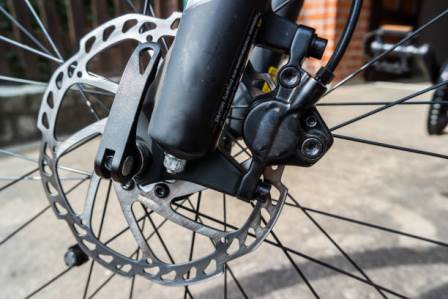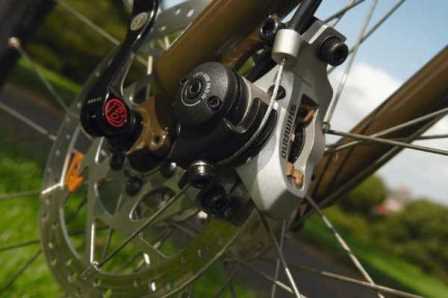Today, almost every serious cyclist has disc brakes equipped on their bike. You will find this type of braking system in many mountain bikes and road bikes. Disc brakes provide better and consistent braking. They also offer reliable performance in wet weather and reduce wear on your bike’s wheels.
Other reasons why many cyclists prefer disc brakes is because they offer faster rides and amazing clearance. If you have this type of braking system on your bike, it is great to understand its working mechanism. In this guide, we will take you through how disc brakes work and what you should focus on.
Types Of Disk Brakes
There are two main types of disk brakes available. One is mechanical, and the other is hydraulic. Mechanical disk brakes are similar to rim brakes because they use a cable. On the other hand, hydraulic brakes use fluid in a sealed line. I will break down in details how mechanical and hydraulic disc brakes work.
How Do Hydraulic Disc Brakes Work?
One of the advantages of disk brakes is to provide better stopping power. However, disk brakes need a lot of effort to work perfectly, and that’s where hydraulic system come in.
Hydraulic disk brakes provide an effortless and predictable way to insert force without using the pulleys' rattrap. This feature applies mainly to the motorcycle industry but also widely used in the cycling sector.
Under normal situations, liquids are very incompressible. For example, we can connect more liquid containers using a pipe and multiply pressure on one of the containers to transfer it directly to the other container.

The above example indicates the importance of hydraulic disc brakes. The pressure on the containers will remain even if the containers are equal.
That's is a better way, though a nutshell, of explaining how hydraulic disk brakes work. First, two containers filled with fluid are connected with a hose. Then, the smaller cylinder (called master) contains a lever that secures with a small piston.
The fluid helps to transmit the hydraulic pressure to the brake caliper when the piston moves. The work of the larger piston is to insert force that presses the brake against the disk, slowing the bike.
As you have seen, it is possible to build changing degrees of power for controlling the size difference between the caliper and the small cylinder.
Advantages Of Hydraulic Disk Brakes:
Disadvantages Of Hydraulic Disc Brakes:
How to Maintain Hydraulic Disk Brakes?
Hydraulic brakes are very reliable, and you'll need to follow a daily routine to keep them working. So here are few ways to make your everyday ride more exciting.
A) Check The Brake Fluid:
Some bikes use DOT 4 brake fluid, just like motorcycles. This is a hygroscopic fluid and can absorb atmosphere water. The brake fluid pulls down its boiling point when more water becomes entrained.
You need to check on your brake fluid frequently. Then, if the need arises, you should change the fluid as recommended in the user manual. This way, you will protect your favorite bike's finish and yourself as well.
B) Make Improvements:
Hydraulic disk brakes offer you an opportunity to improve on braking system. You can buy some aftermarket pads for your bike. This includes replacing the entire stock pads with some bewildering array on the market.
It is easy to find sintered pads, red pads, organic pads, or standard pads. So, how do you know the suitable pads to purchase?
Check on your bicycle catalog and look at which EBC, SBS, DP that the manufacturer of the brakes recommends. Moreover, it is essential to consider the pad material. One of the most popular types of pads is organic. Sintered pads are also popular though they are slightly expensive.
How Do Mechanical Disc Brakes Work?
Also called cable-actuated brakes, mechanical disc brakes were the first disk braking system to enter the market. They resemble rim brakes in a working mechanism. However, the difference lies in the point of contact. Disk brakes apply pressure on the rotor and not the rim.

How To Setup Mechanical Disc Brakes?
When it comes to installation, mechanical disc brakes are pretty simple. They involve a mechanical disk, brake lever, and a cable. This open design has a lot of advantages and disadvantages too.
Since everything is in the open, it is easier to make repairs and another maintenance routine. For example, mechanical disc brakes don't need a lot of maintenance. However, it would help if you tightened the levers when loose.
The biggest drawback is constant cleaning because of the collection of dust and small objects when riding. In addition, the accumulation of debris in the braking system reduces the power stoppage making it dangerous to ride.
Read : How To Store A Bike In An Apartment – 10 Techniques You Should Follow
How Do They work?
It is easy to understand how mechanical disk brake's function. First, you need to apply pressure on the brake levers to activate the steel cable. This process creates friction between the rotor and the brake wheel pad.
The resistance from the friction helps to stop the bicycle when you squeeze the brake levers. This simple process is the reason why mechanical disk brakes are effortless to use.
This system is easy to adjust and very convenient for beginners. You don’t need any learning curve to operate these brakes.
Advantages Of Mechanical Disc Brakes:
Disadvantages Of Mechanical Disc Brakes:
How To Adjust Mechanical Disc Brake Performance?
It is easy to adjust the performance of the mechanical brake. First, inspect the pads or the rotors in case of any contaminants. Then, clean the rotor and remove any unwanted residue.
Moreover, you need to adjust the fixed pad and the moving pad differently. First, align the caliper and thread the stationary pad. It would be best if you also tightened the brake cable frequently.
Frequently Asked Questions - FAQs
Q: How do you convert disc brakes to a bike?
A: You will need a disk brake adapter, a disk brake hub, a disc brake caliper and a welding gear. Start by fitting the adapter and make sure that the wheel is moving correctly.
Also, ensure that the disc surface and the brake pads are aligned. Then, make any adjustments until you get a perfect fit.
Q: Are disk bakes better on bikes?
A: Yes. Disk brakes provide better braking power more than rim brakes. Furthermore, they are reliable in wet weather and ensures a faster ride. Disk brakes also reduce wear on wheels.
Q: How much weight do disc brakes add to a road bike?
A: Disk brakes add about 450g to the whole bike. This weight does not affect the stoppage power of the cycle.
Q: How long do disk brakes last on a bike?
A: Disk brakes have a lifespan ranging from 500 to 1250 miles. Several factors determine the lifespan of the braking system. These factors include the type of brakes, the terrain, weather conditions, and how you usually brake.
Q: What is the benefit of disk brakes on a bike?
A: Disk brakes allow you to brake more consistently and gives your bike better stoppage power. Moreover, they are more reliable in wet weather and gives you a faster ride.
Q: Can I add disc brakes to any bike?
A: It is possible to add disk brakes to any road bike, provided you do it the right way.
Q: How do I make my bike disc brakes more responsive?
A: First, ensure you clean your rotors and pads in case of mechanical disk brakes. Then, for the hydraulic system, bleed the brakes frequently.
Q: Why do road bikes not use disc brakes?
A: Disk brakes add unnecessary weight to the wheels, which might make the bike less controllable. Also, there are concerns that disk brakes give bikes an abrupt stoppage, which can cause crashes.
Q: Are the disk brakes worth it?
A: Yes, disk brakes are worth it, although v-brakes can also do a perfect job. But, first, you need to understand how the system works to avoid accidents.
Q: Do pro cyclists use disc brakes?
A: According to insiders, disk brakes will soon replace the standard calipers in the professional peloton. Currently, disc brakes are not popular among pros, but in the future, they will.
Conclusion
It is only a matter of time for the disk brakes to become more prevalent in the cycling peloton. So for an event rider, it is good to consider installing disc brakes for your bike.
Disk brakes provide better stoppage power even in a wet condition. First, however, it is crucial to understand how the braking system works to avoid braking abruptly.

Hello Guys! I am John Reese, a professional biker and my hobby is biking! I have been biking for last 10 years and I love using bikes while outing as well. Based on my experiences with the different type of bikes (mountain bikes, road bikes and hybrid bikes); I am sharing my opinion about various bikes so that a beginner can get started right away. Happy reading!

